Battleship Galaxies – Boardgame Review
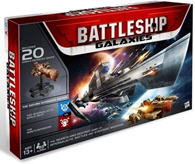 Battleship Galaxies. Boardgame Review. Publisher: Hasbro. Designer: Craig Van Ness. $65
Battleship Galaxies. Boardgame Review. Publisher: Hasbro. Designer: Craig Van Ness. $65
Passed Inspection: Beer and pretzels-style play yet with depth. Plenty of chances for player customization thanks to deck-building and a point-based fleet system. Very replayable. Nice components.
Failed Basic: Attaching pegs to the bases of small ships slightly annoying. More of everything would be great.
Forget global warming, Mayan doomsday calendars, secret FEMA concentration camps beneath the Denver airport, and the fact that Carrot Top makes more money than you ever will. Battleship Galaxies is truly one of the thirteen signs of the Apocalypse. A new tactical sci-fi starship game from—surprise!—Hasbro. It even pays homage to Battleship, that cheesy guessing game of our youth. Surely it can’t be the least bit good, right?
{default}Yet, it is good. Quite good, in fact.
From Hasbro. Loosely based off of Battleship. Oh my. Cats and dogs living together, all that jazz. (Scott is an old-school grognard who has never found it in his heart to forgive Hasbro’s business decision not to re-publish many of the old Avalon Hill wargames after acquiring the rights to them. He spends many evenings launching divisions of panzers from War in the East at hapless Soviet Axis & Allies Miniatures. He leads a support group on the Armchair General gaming forums if you’re interested. —Ed.)
Battleship Galaxies (henceforth Galaxies) is a board game of tactical starship battles between the human-centric ISN (Intergalactic Space Navy) and the Wretcheridians (Wretch for short, and yes, it is a terrible name). A comic from IDW is included to provide background on the game, in case killing bug-eyed aliens had to have some sort of motivation.
Components are quite good, about equal to the bits one expects to find in a Days of Wonder or Fantasy Flight Games box. Two hard-mounted hex maps are included that feature some really nice starfield backgrounds. Unfortunately they also suffer from the “American Valley†syndrome, of which in this day and age there is no excuse not to have nice European folds. Galaxies makes use of cards, both for tracking ship data and as player controlled tactical events, and these are generally good although a little on the thin side.
Ships in Galaxies are depicted with plastic miniatures of three sizes, from the large multi-hex battleships (about three or so inches in length) to small one-hex fighters. The sculpts aren’t bad. ISN ships tend to look like something out of Macross or Aliens (think jet fighters but in spaaaaaacce), while the Wretches have a slightly industrial look to them. Paint jobs are simplistic but work; solid base coat with an ink wash.
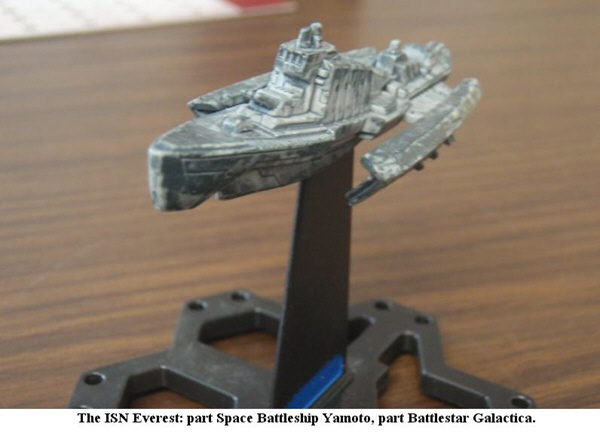
Each miniature has a base that allows pegs to be placed in them to track shields and hull hits. The use of pegs to track damage is one of two nods to the original game of Battleship.
Galaxies is a scenario-based game system with five included scenarios that range from a straight-up knife fight in space to larger, multi-layered affairs. While it seems to work best with two players, the game can support teams by splitting up a side’s forces. Creating new scenarios is pretty easy to accomplish, especially if players are just looking to duel without overcomplicating the mission parameters. Like a miniatures game, the system uses point-based fleet construction, and like a collectible-card game players can create their own tactic decks from the thirty-six card (per side) deck included in the game. So, creating a new scenario is as easy as saying the mission will be thirty-two points of ships and twenty cards per deck.

The basic scenario unfolds first with the two sides dicing for initiative. Once initiative is established each side goes through three phases that constitutes a turn: Energy, Deploy, Action.
Energy management is one of the core mechanics in Galaxies. Unlike other starship games, though, Galaxies uses one energy pool for all vessels to simplify matters. Each turn a side gains ten units of energy, and possibly more if controlling certain objectives in some scenarios or discarding cards, which is added to whatever energy remained from the previous turn. Energy is used to deploy vessels onto the battlefield, to activate ships already on the map, to attach cards, to use certain weapons, and more. Without enough energy a player’s activities will be limited, and as one can imagine, there is never enough energy to do everything desired.
Once energy is collected the player can spend energy to deploy any starships that have not yet entered the battle in the Deploy phase. While some scenarios begin with units already on the map, typically the game begins with nothing on the map and the players bring them in as the game progresses. The initial cost is always rather expensive, making the decision as to when to bring in a ship one important factor to consider. Do you bring the big guns in early, taking the energy hit before having a chance to really build up? Of course early in the game there won’t be as many ships vying for energy, so conceivably taking the hit early is the best option. But then perhaps your opponent will be able to take advantage of the situation, playing plenty of cards while all your energy goes to one ship.
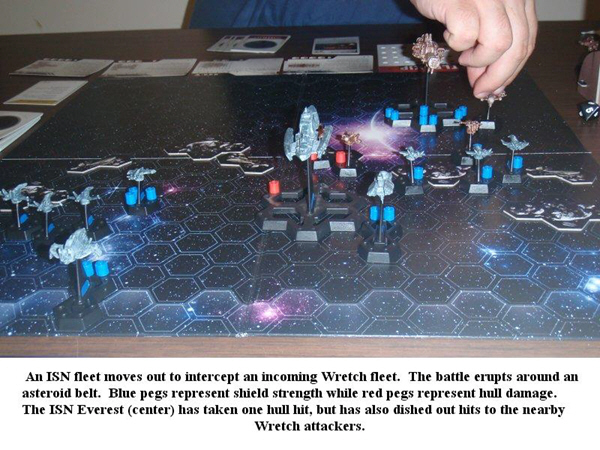
After deploying vessels comes the Action phase, and you guessed it: it’s where all the action takes place. During a player’s Action phase starships activate, move, and battle. Tactic cards can be attached or played. Dice are rolled and violence ensues.
Combat is pretty straightforward. Weapons within range of a target can fire on it. There are no LOS restrictions (but small and medium ships adjacent to an asteroid field do gain cover) and all firing arcs are 360 degrees. Weapons that have multiple shots (or multiple weapons) may fire on multiple targets.
Resolution of firing is handled in a rather clever manner that is meant to evoke Battleship. Every ship card has a top down view of the starship on a ten by eight grid. The X-axis is lettered A through J, while the Y-axis is numbered one through eight. Grid locations that feature elements of the ship are hits. Furthermore, one or two grid locations are marked as critical hit locations, meaning one shot to that particular grid will instantly destroy the ship. Capital ships tend to be easiest to hit, taking up the majority of the grid, while the smaller, nimbler craft tend to be much more difficult to strike.
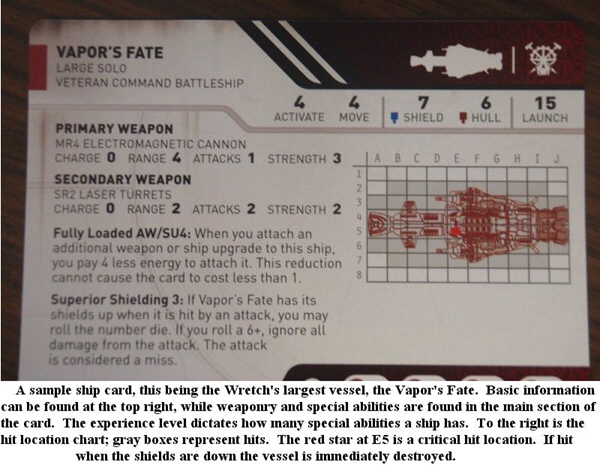
To determine a hit the firing player rolls two dice: a standard d8 and a d10 that is marked not with the usual digits, but rather with letters. The combination provides the grid location that has been struck. If a ship is hit the strength of the weapon causes a certain number of hits, with shields being removed before hull hits are incurred.
While, yes, there is something inherently silly about calling out “C6†as an adult, it really is a neat little system for dishing out damage. With a few tweaks it could even handle component damage, with certain grid locations representing engines, weapons, and so on.
Combat is thankfully more than lining up broadsides and hammering away at each other. Ships come in three levels of experience (and point cost), with special abilities being added in conjunction with experience levels. Because of this the special abilities of ships will factor into how a battle plays out. For example, one particular Wretch ship at its highest level gains a bonus against fighters, in addition to being adept at moving through asteroid and debris fields, making it a no-brainer to bring along on maps featuring asteroids.
Then there are the Tactic cards. Scenarios either allow players to draft their own deck of Tactic cards or provide a list of cards to include. Draws are random and done each turn, but since the players have fine-tuned their decks they have an idea of what to expect (and hopefully made the correct choices for their particular scenario strategy) when drawing. Tactic cards allow heroes to be attached to ships, additional weapons such as nukes and ranged based cannons, boarding actions, and instant actions such as dealing extra damage with weapons for that turn.
One of the joys of the game is trying out the possible combinations of Tactic cards. Which ships benefit the most from attaching weapons? Do you put your heroes on the obvious ships or see what kind of effect they have when commanding a less than top-of-the-line craft?
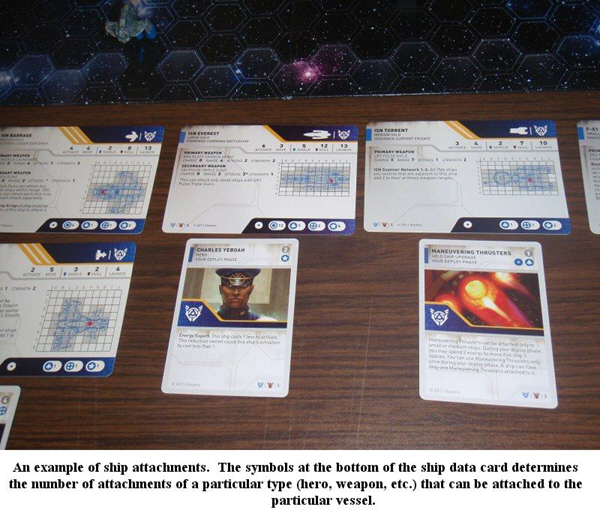
Between the variety of ships, the multitude of possibilities with the cards, and the ability to customize both your fleet and deck—not to mention scenario specific rules—Galaxies really offers an amazing amount of depth. Even though the core scenario selection may seem slim replayability is extremely high, thanks to all these factors, allowing a variety of tactics to be tried. Quality or quantity? A hero-laden deck or one full of events?
The flaws in Galaxies all stem not from what was included, but what wasn’t. It’s easy to want more ship classes, more cards, more rules. This is a game that starts conversations afterwards, and these discussions will quickly turn to a series of what may yet be included in the system. Dedicated carriers, minefields, jamming, damage control, cloaking, the list goes on. The possibilities are endless, as anyone who has ever played Star Fleet Battles or Federation Commander can attest to.
This leads to the question: if someone desires all that, why not go with something like Star Fleet Battles? Easy, Battleship Galaxies is a great beer and pretzels-style game, one that can be explained in a few minutes, played in an hour or two, and enjoyed by a variety of gamers. This is a perfect pick-up-and-play game. Galaxies is a hobby, Star Fleet Battles a career.
Having a Hasbro game sitting between War in the East and Outremer on your shelf may raise a few eyebrows, but Battleship Galaxies is a worthy addition to any collection looking for a fast-playing, replayable, sci-fi tactical game with a surprising amount of possibilities.
Armchair General Rating: 90%
Solitaire Suitability: 3 Vogon poets out of 5. Other than hiding ships not yet deployed from your opponent, there is no fog of war.
About the Author
A warrior-poet who launches his excursions into the heart of darkness from historic Roswell, Georgia, Scott R. Krol started gaming in the early ‘70s and has wasted his life with it ever since. Professionally he began writing about games in the mid-nineties at Gamespot, and is currently employed by Shrapnel Games. He also contributes wacky cartoons to the magazine Knights of the Dinner Table, and enjoys raising ferocious beasts to terrorize the neighborhood children.


Thanks Scott,
This review gave me much more information than Hasborg’s website did. Can you tell me what age range is recommended, I’m wondering if it’s too much for my seven year old son?
Go to http://www.boardgamegeek.com for more on this and other games. They do Ameritrash games like this and any other type boardgame.
The age on the box is listed as 13+. I do not believe that the age rating is correct and I would say it is more like 8+.
I read somewhere on BGG (and I can’t find it now) that most new board games are going to be rated 13+, not becasue they actually merit that rating due to theme or rules complexity, but because recent regulatory changes make it more expensive to safety test games rated for younger players. The magic cutoff age seems to be 13, so if all the games are “rated” at 13+ the manufacturer avoids the extra expense and the onus is on the consumer rather than the company if there is a safety issues -such as a small fighter ship being lodged in a youth’s nose or being swallowed, etc. This is yet another example of how nanny statism run amok causes unintended consequences with well intentioned but misguided regulation. But hey…its for the kids. So now the rating system is virtually meaningless.